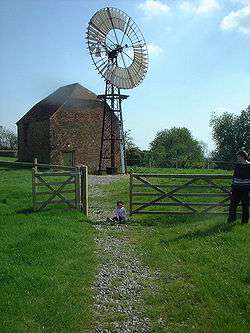Crux Easton wind engine
| Crux Easton Wind Engine | |
|---|---|
|
The restored wind engine | |
| Origin | |
| Mill name | Crux Easton wind engine |
| Grid reference | SU 4267 5634 |
| Coordinates | 51°18′17″N 1°23′21″W / 51.3046°N 1.3892°WCoordinates: 51°18′17″N 1°23′21″W / 51.3046°N 1.3892°W |
| Operator(s) | Crux Easton Wind Engine Restoration Trust |
| Year built | 1891 |
| Information | |
| Purpose | Pumping mill, sawmill and corn mill |
| Type | Simplex geared wind engine |
| No. of sails | One sail |
| Type of sails | Annular sail |
| Winding | Fantail |
| Fantail blades | Six blades |
| No. of pairs of millstones | One pair |
| Type of saw | Circular saw |
| Other information | Built by John Wallis Titt |
Crux Easton wind engine is a Grade II listed[1] Titt wind engine at Crux Easton, Hampshire, England which has been restored to working order.
History
Erected for the Earl of Carnarvon in 1891. The wind engine pumped water from a well 410 feet (125 m) deep.[2] It was last used in the 1920s.[3] The sails were removed in the 1960s and placed in storage.[1] Restoration of the wind engine was undertaken by Hampshire Industrial Archaeology Society and Hampshire Mills Group with assistance from the British Engineerium, Hove for the Crux Easton Wind Engine Restoration Trust. The restoration was funded by the Heritage Lottery Fund, which was asked to contribute £149,750 of the estimated £226,180 cost. Other grants were received from Basingstoke & Deane District Council, Hampshire County Council.[3] and the Vodafone Charitable Trust. Restoration of the wind engine was delayed due to an outbreak of Foot and Mouth disease. The restored wind engine was officially opened on 25 September 2002 by Sir George Young.[4]
Description
Crux Easton wind engine is a Titt Simplex geared wind engine. It has a 20 feet (6.10 m) diameter sail[3] mounted on a 35 feet (10.67 m) hexagonal steel tower.[5] The annular sail has 48 blades, each one 5 feet (1.52 m) long.[6] It is winded by a six blade fantail.[3] The wind engine was primarily used for pumping water, but also drove a circular saw and a pair of millstones. The mill is recorded as being capable of producing eight to ten sacks of flour per day.[2][7]
Public access
Crux Easton wind engine is open from 11:00 to 16:00 on the second Sunday of each month from April to August, plus both days of National Mills weekend. It is open at other times by appointment.
References
- 1 2 "Wind engine and former mill house, Ashmansworth, Basingstoke and Deane". English Heritage. Retrieved 22 May 2009.
- 1 2 Major, J Kenneth (1977). The Windmills of John Wallis Titt. The International Molinological Society.
- 1 2 3 4 "Restoring the Crux Easton Wind Engine". Hampshire Industrial Archaeology Society. Archived from the original on December 2, 2008. Retrieved 22 May 2009.
- ↑ Newbury Weekly News 26 September 2002 (Online article Archived 2012-10-21 at the Wayback Machine.)
- ↑ "Crux Easton Wind Engine". Society for the Protection of Ancient Buildings. Retrieved 22 May 2009.
- ↑ "Crux Easton Wind Engine". Hampshire Mills Group. Retrieved 22 May 2009.
- ↑ Note: A sack of flour weighed 20 stone (130 kg)
